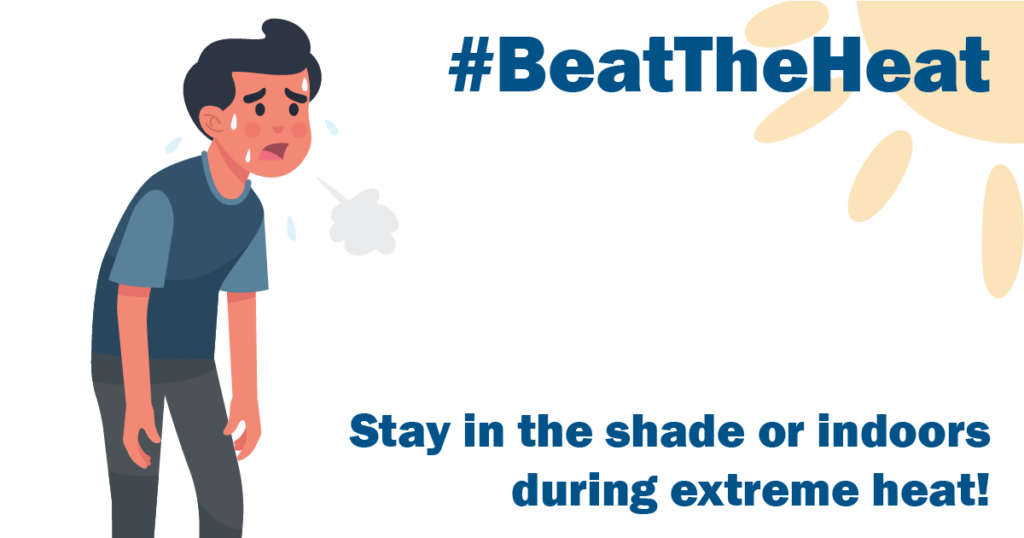Understanding Extreme Heat
Extreme heat happens when temperatures rise much higher than usual for an area. In El Dorado County, this can happen anywhere, though the valley areas are usually the hottest. Extreme heat can make other problems worse, like droughts and wildfires, and can even cause more trees to die. Sometimes, power companies may shut off electricity to prevent wildfires during very hot, dry, and windy weather.
Extreme heat is dangerous because it can lead to heat-related illnesses like heat cramps, heat exhaustion, and heat stroke.
Extreme heat also puts a lot of pressure on power lines. With more people using air conditioning, power lines can get overloaded, causing brownouts (lower power) or even blackouts (no power).
If the power goes out, it’s important to know what to do to stay safe. For tips on what to do during a power outage, click here.

What to Do During an Extreme Heat Event
- Stay Indoors: Stay inside during the hottest parts of the day whenever possible. If you need to go outside, limit your time outdoors and take regular breaks.
- Cool Your Home: Use fans, take cool showers, or apply cool compresses to help lower your body temperature.
- Stay Alert for Heat Warnings: Pay attention to local news and El Dorado County emergency services for updated heat advisories or warnings.
In Case of Emergency
If You or Someone Else Shows Signs of Heatstroke:
- Call 911 or emergency services immediately.
- Move the person to a cooler location.
- Try to cool the person by applying cold compresses or ice packs.
- Do not attempt to give fluids to someone who is unconscious or vomiting.
1. Stay Informed
- Monitor Heat Alerts: Stay updated on weather forecasts and heat advisories from reliable sources, such as your local weather station, National Weather Service, or official government websites.
- Sign Up for Emergency Alerts: Many local jurisdictions offer heat warnings and other emergency notifications. Sign up for text alerts to receive real-time updates.
2. Create a Heat Safety Plan
- Know the Signs of Heat-Related Illnesses: Be familiar with symptoms of heat exhaustion (e.g., dizziness, heavy sweating, nausea) and heatstroke (e.g., confusion, hot, dry skin, rapid pulse). Understand when to seek medical help.
- Emergency Contacts: Identify and make a list of emergency contacts, including family members, neighbors, or local health services. Ensure that vulnerable individuals have someone checking on them during extreme heat events.
3. Protect Your Home and Property
- Prepare Your Cooling System: If you have air conditioning, ensure it is working and maintain it regularly. If you don’t have air conditioning, consider using fans or visiting air-conditioned public spaces such as one of the El Dorado County libraries or community centers during the hottest part of the day.
- Block Out the Heat: Close blinds or curtains to reduce heat buildup from the sun. You may also want to install reflective window films or use shades to keep indoor temperatures down.
- Block Out the Heat: Close blinds or curtains to reduce heat buildup from the sun. You may also want to install reflective window films or use shades to keep indoor temperatures down.
- Seal Windows and Doors: Ensure windows and doors are properly sealed to prevent heat from entering your home and air conditioning from escaping.
4. Stay Hydrated
- Drink Plenty of Water: Keep hydrated by drinking water regularly, even if you do not feel thirsty. Avoid alcohol or drinks with caffeine as they can increase dehydration.
- Stock Up on Essentials: Ensure you have an adequate supply of water and other necessities in case of a power outage or other emergency. This should include at least one gallon of water per person, per day, for at least three days. Plan ahead and build a kit.
5. Limit Outdoor Activities
- Reschedule Activities: Avoid outdoor activities during peak heat, typically between 10 AM and 4 PM. If you must be outdoors, take frequent breaks in the shade and drink water regularly.
- Wear Appropriate Clothing: Dress in lightweight, light-colored clothing and wear a wide-brimmed hat when outside. Apply sunscreen to prevent heat-related skin damage.
6. Check on Vulnerable Activities
- Monitor At-Risk Populations: Check on elderly family members, neighbors, and those with chronic health conditions. Make sure they have access to cool environments and plenty of water.
- Create a Cooling Network: In your community, establish a network of neighbors who can assist each other in times of extreme heat. Share resources such as fans, water, and transportation to cooling centers.
7. Emergency Preparedness for Heat-Related Medical Conditions
- Learn First Aid: Know how to recognize and respond to heat exhaustion and heatstroke. In the event of heatstroke, seek immediate medical help and attempt to cool the person by moving them to a shaded area and applying cool compresses.
- Have a Plan for Medical Needs: If you or someone in your household has health conditions that make them more susceptible to extreme heat, make sure you have access to needed medications and medical care.
8. Prepare for Power Outages
- Back-Up Power: Consider investing in a portable power generator if you live in an area prone to power outages during heat events.
- Unplug Non-Essential Appliances: During an extreme heat event, power grids may become stressed. Unplugging unnecessary devices can help prevent electrical surges and reduce the strain on the system.
9. Know Local Cooling Centers
- Find Cooling Locations: Many local governments open public cooling centers during extreme heat events. Know the locations of nearby cooling centers, libraries, or community centers where you can find relief during a heat wave. Contact Us if you need assistance.
Additional Resources
Extreme Heat Information Sheet – Click here
National Weather Service (NWS): www.weather.gov
Centers for Disease Control and Prevention (CDC): www.cdc.gov
Red Cross Heat Safety Tips: www.redcross.org
